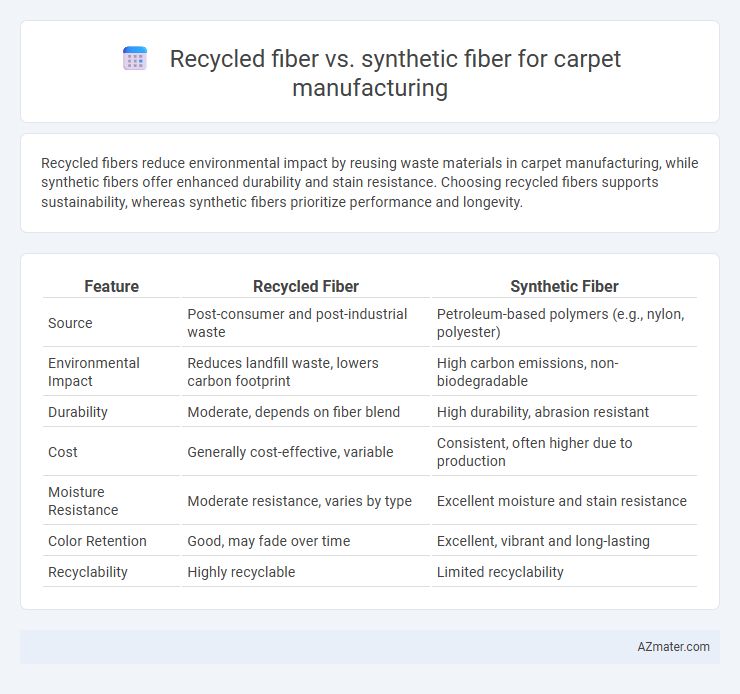Recycled fibers reduce environmental impact by reusing waste materials in carpet manufacturing, while synthetic fibers offer enhanced durability and stain resistance. Choosing recycled fibers supports sustainability, whereas synthetic fibers prioritize performance and longevity.
Table of Comparison
| Feature | Recycled Fiber | Synthetic Fiber |
|---|---|---|
| Source | Post-consumer and post-industrial waste | Petroleum-based polymers (e.g., nylon, polyester) |
| Environmental Impact | Reduces landfill waste, lowers carbon footprint | High carbon emissions, non-biodegradable |
| Durability | Moderate, depends on fiber blend | High durability, abrasion resistant |
| Cost | Generally cost-effective, variable | Consistent, often higher due to production |
| Moisture Resistance | Moderate resistance, varies by type | Excellent moisture and stain resistance |
| Color Retention | Good, may fade over time | Excellent, vibrant and long-lasting |
| Recyclability | Highly recyclable | Limited recyclability |
Introduction to Carpet Fiber Types
Recycled fibers in carpet manufacturing offer eco-friendly benefits by utilizing post-consumer or post-industrial waste materials, reducing landfill impact and conserving natural resources. Synthetic fibers such as nylon, polyester, and polypropylene provide durability, stain resistance, and cost-effectiveness, making them the most widely used materials in residential and commercial carpets. Comparing recycled and synthetic fibers highlights the trade-off between sustainability and performance attributes crucial for carpet production decisions.
Overview of Recycled Fibers in Carpets
Recycled fibers in carpet manufacturing primarily consist of reclaimed natural materials such as wool and cotton, as well as post-consumer plastics like PET from bottles. These fibers contribute to sustainability by reducing landfill waste and lowering the carbon footprint compared to synthetic fibers derived from petrochemicals. Utilizing recycled fibers enhances the eco-friendliness of carpets while maintaining durability and aesthetic appeal in commercial and residential applications.
Properties and Benefits of Synthetic Fibers
Synthetic fibers used in carpet manufacturing, such as nylon, polyester, and polypropylene, offer superior durability, stain resistance, and color retention compared to recycled fibers. These fibers exhibit high tensile strength and resilience, which contribute to longer carpet life and better performance in high-traffic areas. Their moisture resistance and ability to repel allergens make synthetic fiber carpets an ideal choice for maintaining indoor air quality and reducing maintenance costs.
Environmental Impact: Recycled vs Synthetic Fibers
Recycled fibers in carpet manufacturing significantly reduce landfill waste by repurposing post-consumer materials, lowering overall environmental footprint compared to synthetic fibers derived from petrochemicals. Synthetic fibers such as nylon and polyester rely heavily on non-renewable fossil fuels, contributing to greenhouse gas emissions and microplastic pollution during degradation. Employing recycled fibers supports circular economy principles, decreases dependency on virgin resources, and enhances sustainability through reduced energy consumption and carbon emissions in production processes.
Durability and Longevity Comparison
Recycled fibers in carpet manufacturing offer moderate durability and environmental benefits, but synthetic fibers such as nylon and polyester provide superior strength, abrasion resistance, and longer lifespan under heavy foot traffic. Nylon carpets typically last 10-15 years due to excellent elasticity and resilience, while polyester fibers often exceed a decade with better stain resistance yet lower abrasion tolerance. Recycled fibers degrade faster under stress and UV exposure, making synthetic fibers the preferred choice for high-traffic, long-lasting carpet installations.
Aesthetic Qualities and Design Flexibility
Recycled fiber in carpet manufacturing offers a natural, textured appearance that enhances aesthetic appeal while promoting sustainability through the reuse of materials like PET from plastic bottles. Synthetic fibers provide exceptional design flexibility with a broad palette of vibrant colors, consistent texture, and the ability to mimic natural fibers, enabling intricate patterns and modern styles. Both options cater to diverse design needs, but recycled fibers emphasize eco-friendly aesthetics, whereas synthetic fibers excel in vibrant customization and durability.
Cost Analysis: Recycled vs Synthetic Carpet Options
Recycled fibers typically reduce carpet manufacturing costs by utilizing reclaimed materials, lowering raw material expenses compared to synthetic fibers derived from petroleum-based sources. Synthetic fibers such as nylon or polyester often incur higher production costs due to energy-intensive processes and petrochemical price volatility. However, recycled fiber carpets may offer cost advantages by minimizing environmental impact fees and benefiting from sustainability incentives.
Installation and Maintenance Differences
Recycled fiber carpets offer easier installation due to their lightweight and flexible nature, reducing labor time and effort compared to synthetic fiber counterparts, which can be stiffer and require specialized tools. Maintenance of recycled fiber carpets often involves more frequent vacuuming to prevent dirt accumulation, while synthetic fiber carpets provide enhanced stain resistance and durability, allowing for less intensive cleaning routines. Synthetic fibers such as nylon or polyester typically withstand harsh cleaning agents better, ensuring longevity and maintaining appearance over time in commercial and residential settings.
Consumer Preferences and Market Trends
Consumer preferences are increasingly favoring recycled fibers in carpet manufacturing due to growing environmental awareness and demand for sustainable products. Market trends indicate a surge in the use of recycled polyester and nylon fibers, which offer comparable durability and performance to synthetic fibers while reducing carbon footprints. Brands adopting recycled fiber carpets are gaining competitive advantages by aligning with eco-conscious buyers and regulatory pressures on sustainability.
Future Prospects in Carpet Fiber Innovation
Recycled fiber offers significant environmental benefits by reducing waste and lowering resource consumption in carpet manufacturing, positioning it as a key player in sustainable innovation. Synthetic fibers continue to evolve with advancements in biobased polymers and enhanced durability, catering to performance demands while addressing ecological concerns. Future prospects hinge on hybrid materials combining recycled and synthetic fibers to optimize functionality, cost-efficiency, and environmental impact in next-generation carpet production.

Infographic: Recycled fiber vs Synthetic fiber for Carpet manufacturing
 azmater.com
azmater.com